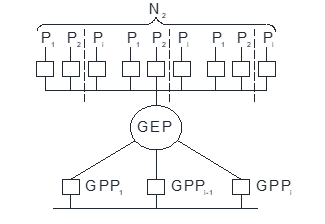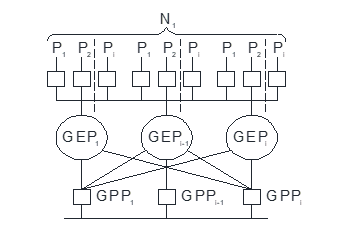Abstract
Level educational system is one of the most promising means of conscious control of educational reforms. The main idea is to partition the content disciplines being integrated into elementary components and to form training thesaurus (structured sets of elementary components and connections between them). Then comes the overlap of discipline thesauri, distinguishing of areas of their mutual "overlap" and synthesizing. Improving of the efficiency and training quality is achieved by the use of a branched structure (structuring) of each studied course and the curriculum as a whole. Within the professional discipline engineering activity involves the allocation of some "knowledge core" around which various "applications" are implemented. This procedure is multi-stage and multi-tired. If students are taught to use this technique, then from the point of view of the systems theory, it is possible to move from a closed system in which goals are set from the outside, to an open system with active elements, in which goals are formed within the system on the basis of self-movement, and to intensify cognitive activity. The technique considered in this paper can serve as a basis for the creation of active training systems, when the learner evaluates the cost-quality ratio for the multi-link trajectory of training. It is obvious that for its implementation it is necessary to train students the basics of optimization.
Keywords: System of educationLagrange function“core structure”implementation rateblock structure
Introduction
In a modern industrial society, the main component of industrial production is human resources. Science and technology progress at the present stage of industrial society development is largely determined by the availability of highly qualified labor resources. The experience of industrialized countries shows that during the periods of structural transformation of the economy, the elimination of crisis phenomena significantly increases the relevance of technical training and retraining issues, advanced training and requalification of industrial production specialists (Chan, Fong, Luk, & Ho, 2017).
Within the professional discipline engineering activity involves the allocation of some "knowledge core" around which various "applications" are implemented. This procedure is multi-stage and multi-tired. For modern industry dealing with the global modernization professional training is conducted on a multi-educational path, and quality and cost assessment of which is a non-trivial task for both the performers and for the consumers of educational services. Path implementation may be performed on the basis of corporate and higher education integration. Training should be conducted in a controlled system providing cost savings, agility, and quality control (Wong & Nguyen, 2019).
Problem Statement
Optimization of the specialists retraining system is a complex problem due to the nonlinearity of the cost-quality relationship and the presence of significant limitations. Therefore, a systematic analysis of specialists retraining models in industrial production, taking into account the functional characteristics and cost of the training trajectories is an up-to-date problem. Focus on the of a systematic approach formation in education as one of the most important requirements of modern life, and its results give an answer to the question: what and how to teach in modern conditions. Functional engineering specialization is provided by complex methodological techniques and organizational methodological methods of carrying out the educational process, by a flexible modular curricula system, multivariate composition and differentiated content of the disciplines module of functional specialization.
The Cobb-Douglas production function is widely used to model the processes characterized by firm, stable production functioning (when the involvement of a new resource unit brings the effect proportional to the average productivity of available resources) (Mesarovich, Mako, & Takakhara, 1973).
Research Questions
Personnel contribution assessment techniques using production functions show a high sensitivity of this component in the resulting production, that commensurate with capital costs, and in some industries – even higher. For example, in industries with widespread use of computers and software, in particular, in power industry, there is an identifiable scientific and technological progress, as there is a need for qualified personnel in this branch of industry.
Nowadays, the need for a systematic approach for solving the theoretical and practical problems of retraining, acquiring a complex nature accounts for life itself (Migunova, 2006). The learning process is a complex of interrelated components with common functioning purpose and management. Therefore, it is possible to reveal the actual conditions, efficiency factors of training only on the basis of the interaction system analysis of the teacher and the student. In the systematic approach, training is considered as a dual activity of the teacher and the student, which has a systemic nature, and the subject of the analysis is the interaction between the teacher and the student. The main purpose of training is to form a certain system of knowledge and skills of each student (Migunova, 2006).
Purpose of the Study
In management of specialists retraining system in industrial production it is necessary to point out the following items: functional purpose of a system – staff of industrial production modernization; elements-didactic units – program and retraining courses sections, subjects; structure – block, multi-link, with consecutive and parallel questions learning, with knowledge "core" and applications; state variables – resource expenses for blocks; diagnostics – tests composing, database formation on parameters of blocks cost; emergence - increasing the cost-quality ratio (efficiency); quality criterion – average score, career success, implementation rate; control actions - the trajectory choice, resource distribution, feedback introduction or the creation of transition conditions to an open system, i.e. to train students the optimization basics, information and technical support of testing, diagnostics and reference training subsystems; organizational support – corporate training and educational centers (CTEC), institutes and departments of advanced training (IAT, DAT), target retraining programs (TRP) at the universities departments (Migunova, 2006). A systematic approach allows to look for the tasks solution by a directed search method, thus providing solutions close to optimal, when costs are much lower than when using the methods of generating ideas (Volkova & Loginova, 2018).
Research Methods
The main professional educational program of different majors is assumed to be based on the general professional part (GPP), and it allows you to implement a variety of modular parts (competence, Pi) (Migunova, Kuregyan, & Vorontsova, 2016; Migunova, 2006).
The curriculum provides for the certain resource allocation (number of hours) on the training trajectory and it is necessary to choose such a training trajectory to ensure the training of a given quality at the minimum cost. In Universities with several specialties in one major, it is possible to create a structure with a single general educational (professional) program (GEP) (Figure
In multidisciplinary universities, the task of creating a structure for training specialists and determining the volume of general professional part, general educational programs and specializations is urgent. Research methods are based on the systems and system analysis theory, criterion-oriented testing, mathematical statistics, dynamic programming method, the method of indefinite Lagrange multipliers, nonlinear coordinate transformation, and the method of least squares.
Findings
A system-wide function is a target function that determines the result within a fixed value of costs, that is, the number of questions
The implementation rate value depends on the allocated resource (for example, the number of training hours) for this unit
where


In this case, the target function for the multichannel training scheme is
where
The Lagrange function is as follows:
where
Conclusion
When you allocate a resource between the elements additive target function is used for which the optimization process can be broken down into separate stages representing the resource allocation to one structure and its distribution between the units of maximum implementation rate for the University as a whole. Course structuring of standardized subjects and curriculum as a whole makes it possible to optimally allocate resources between the elements, to evaluate the effectiveness and quantify various structures. If students are taught this methodology, then in terms of systems theory, it is possible to move from a closed system, in which the goals are set from the outside, to an open system with active elements, in which the goals are formed inside the system on the basis of the self-education process, and to activate cognitive activity (Migunova & Kulakov, 2007).
The methodology involved can serve as a basis for the creation of active learning systems when the learner estimates ratio of cost-quality for the multi-educational learning path. It is evident that for its implementation it is necessary to teach students the basics of optimization.
References
- Chan, C. K. Y., Fong, E. T. Y., Luk, L. Y. Y., & Ho, R. (2017). A review of literature on challenges in the development and implementation of generic competencies in higher education curriculum. International Journal of Educational Development, 57, 1-10.
- Mesarovich, M., Mako, D., & Takakhara, I. (1973). The theory of hierarchical multilevel systems. Moscow: Mir. [in Rus.].
- Migunova, L. G. (2006). System bases of professional retraining of industrial enterprises specialists. (Ph.D. thesis). Samara: SSTU. [in Rus.]
- Migunova, L. G., & Kulakov, P. A. (2007). Optimization of multi-chain learning paths. Moscow: Energoatomizdat. [in Rus.]
- Migunova, L. G., Kuregyan, A. L., & Vorontsova, E. S. (2016). Optimization of multi-educational learning paths. In A. Bataev (Ed.), Proceedings of IFOST-2016 11th International Forum on Strategic Technology (pp. 483-486). Novosibirsk: Novosibirsk State Technical University.
- Volkova, V., & Loginova, A. (2018). Multilevel hierarchical models as a method of conservation of integrated representation in the studying or engineering the system. In V.I. Maevsky, B.I. Erznkyan (Eds.), System analysis in economics - 2018 Proceedings of the V International research and practice conference-biennale (pp. 284-287). Moscow: Prometheus Publishing House.
- Wong, E., & Nguyen, T. V. (2019). Introduction of an integrated curriculum: Early outcomes and experiences within a large private university. Currents in Pharmacy Teaching and Learning, 11(5), 528-532.
Copyright information

This work is licensed under a Creative Commons Attribution-NonCommercial-NoDerivatives 4.0 International License.
About this article
Publication Date
09 March 2020
Article Doi
eBook ISBN
978-1-80296-078-5
Publisher
European Publisher
Volume
79
Print ISBN (optional)
-
Edition Number
1st Edition
Pages
1-1576
Subjects
Business, business ethics, social responsibility, innovation, ethical issues, scientific developments, technological developments
Cite this article as:
Migunova*, L. G., Kuregyan, A. L., & Gneushev, A. S. (2020). Optimization Of Specialists Training Structure By Educational Programs Structuring. In S. I. Ashmarina, & V. V. Mantulenko (Eds.), Global Challenges and Prospects of the Modern Economic Development, vol 79. European Proceedings of Social and Behavioural Sciences (pp. 882-886). European Publisher. https://doi.org/10.15405/epsbs.2020.03.127
